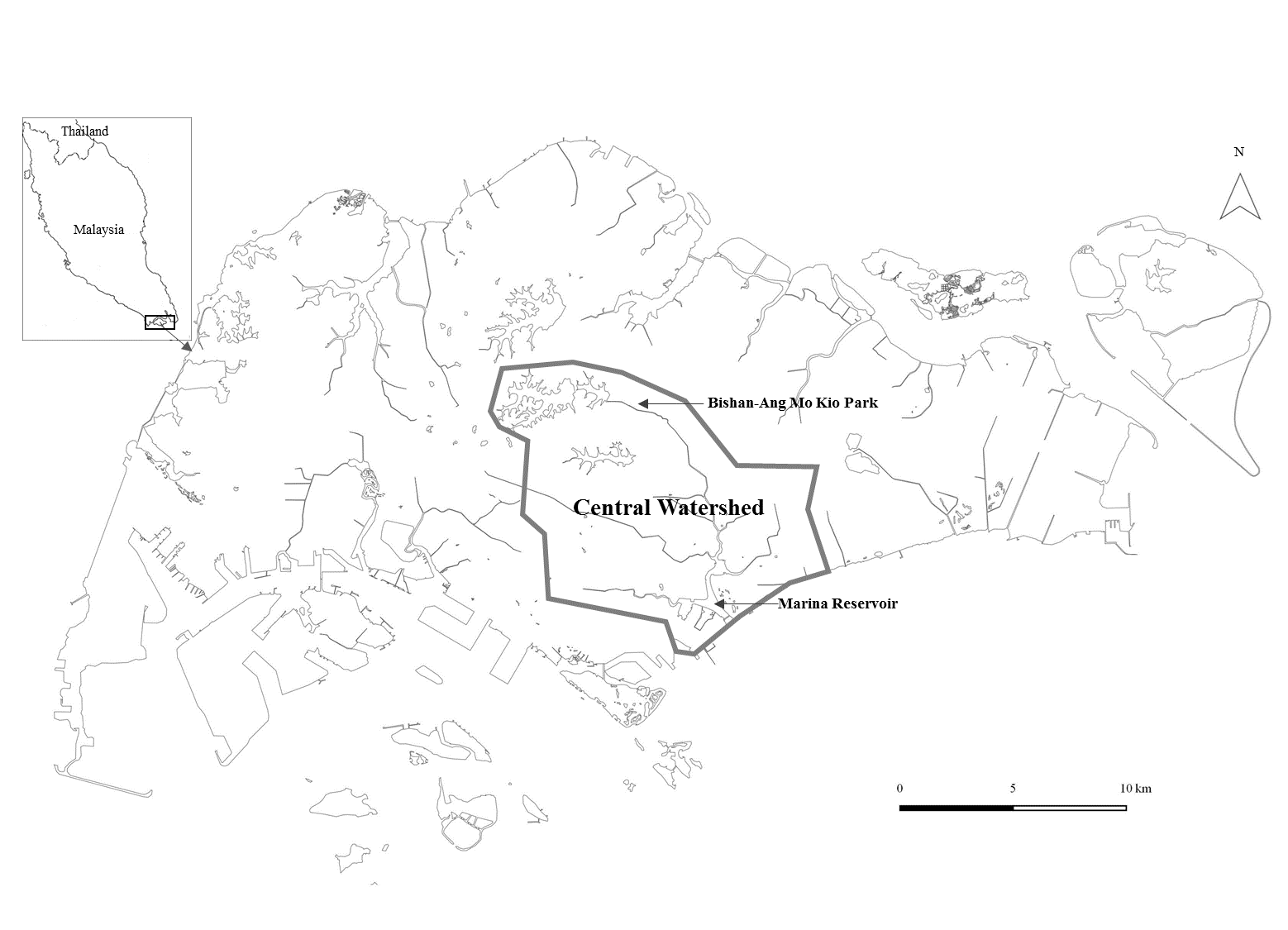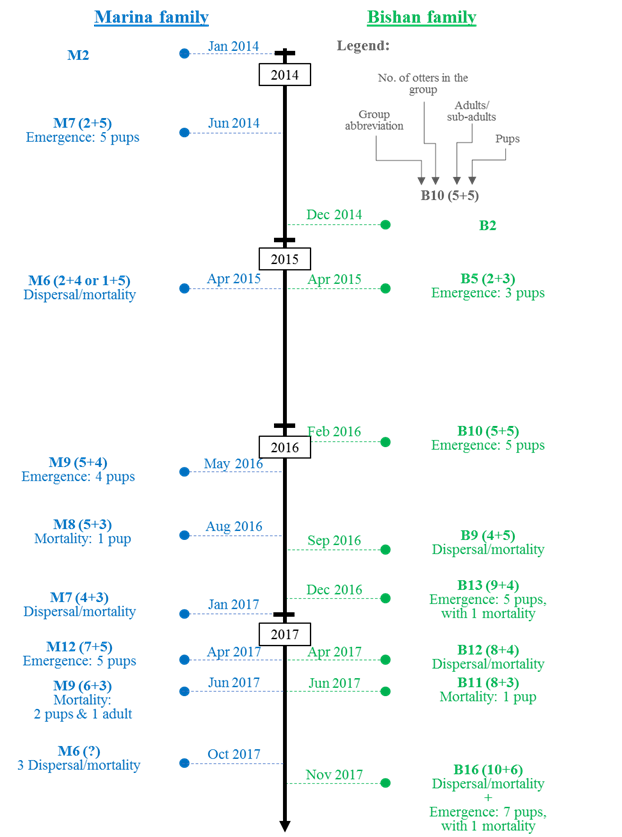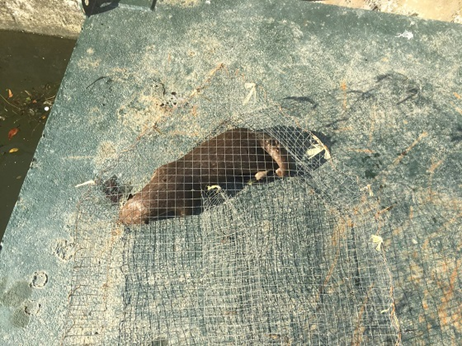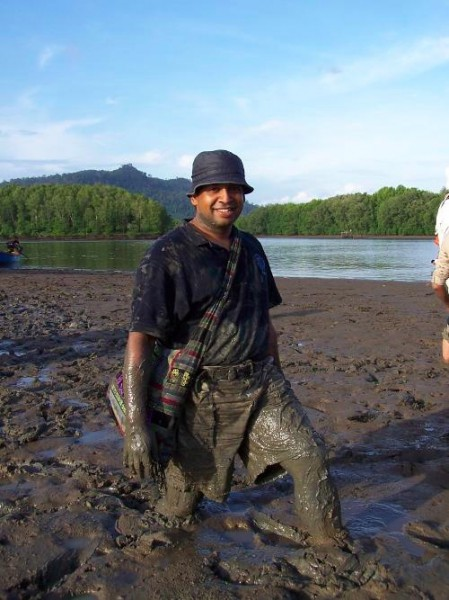IUCN/SSC Otter Specialist Group Bulletin

©IUCN/SCC Otter Specialist Group
Volume 35 Issue 3 (October 2018)
Citation: Khoo, M de Yuan and Sivasothi, N (2018)a. Observations of the Variation in Group Structure of two Urban Smooth-Coated Otter Lutrogale perspicillata Groups in the Central Watershed of Singapore . IUCN Otter Spec. Group Bull. 35 (3): 148 - 154
Observations of the Variation in Group Structure of two Urban Smooth-Coated Otter Lutrogale perspicillata Groups in the Central Watershed of Singapore
Max De Yuan Khoo* and N. Sivasoth
National University of Singapore, Department of Biological Sciences, Science Drive 4, Singapore 117543
*Corresponding author e-mail: khoomaxdeyuan@gmail.com
Received 27th February 2018, accepted 25th February 2018
Abstract: The population and distribution of the smooth-coated otter Lutrogale perspicillata in Singapore have increased since 1998. In recent years, the species has established itself in urban areas with high human exposure within the Central Watershed of Singapore. The ease of following L. perspicillata in such areas has facilitated the monitoring of two urban groups, allowing the temporal variation in their group structures to be scrutinized. Field observations from two studies, and observations from the ground between December 2014 and December 2017, were compiled. Breeding pairs from both groups each gave to a total of seven litters of pups, with a mean litter size of 4.86. A change in group behaviour from pre-pregnancy, pre-natal and to post-natal were observed. Natural mortality resulting from intraspecific aggression and other natural causes, and an instance of anthropogenic mortality, were observed. Wild records of parturition, litter size, movement pattern and mortality are rare for this species from anywhere in its world range
Keywords: smooth-coated otters, Singapore, group structure, home range, breeding
INTRODUCTION
The Smooth-coated otter Lutrogale perspicillata re-established itself in Singapore since 1998, after their apparent absence from the country for three decades (Theng and Sivasothi, 2016). Since then, the population of L. perspicillata has increased and its distribution has widened. This includes establishing in and adapting to urban areas with high human exposure, as observed nowhere else in the world (Theng and Sivasothi, 2016). Within these urban areas in Central Watershed of Singapore, the ease of following L. perspicillata has facilitated its monitoring compared with the challenges of such tracking for groups in wilder habitats. As such, the large numbers of records for two groups of urban L. perspicillata over the years allow temporal variation in group structures to be scrutinized.
STUDY AREA
The Central Watershed of Singapore (Fig. 1) consists of a series of rivers that have been modified into stormwater channels and four reservoirs that drains (Public Utilities Board, n.d.). Two groups of L. perspicillata occupied the Central Watershed area during the study period. In 2014, one group established in Marina Reservoir (1.286°N, 103.8673°E), a freshwater estuarine reservoir created by barraging the river mouth. In 2015, second group established in Bishan-Ang Mo Kio Park (1.3634° N, 103.8436° E), an urban park with a naturalised river. The three kilometer stretch of river in this park was once a concrete canal, and was naturalised and de-concretised in 2012 to form a meandering river with vegetated banks (National Parks Board, 2018).

METHODS
Observations from this study were mainly opportunistic observations from a home range and population structure of L. perspicillata study in June–December 2015 and August 2016 - April 2017. In addition, photographic and videographic records between December 2014 and December 2017 were compiled. The bulk of these records were obtained from a group of 15 otter enthusiasts and photographers, and were verified either by matching the observations to the photographic or videographic evidence, or through ground-truthing by the authors to ensure their accuracy.
RESULTS
Breeding activities
All emergence periods of the seven litters of pups from the natal holt occurred between November and June (Fig. 2), which suggests that parturition occurred between October and May, based on the six week pre-emergence period (see below). Four of the interval periods between parturition were between ten months to 11 months, and one period was 48 months.

Litter sizes
Breeding pairs from the Marina and Bishan groups gave birth to three and four litters respectively, with a mean litter size of 4.86 ± 0.459 (SE) (n=7, range: 3-7).
Differences in group behaviour between pre-pregnancy, pre-natal, and post-natal periods from four litters
L. perspicillata groups were observed to typically travel and go on foraging trips as a whole group when none of the females in the group were pregnant. They changed their holt frequently as well (at least once every three days). During the pre-natal stage (as observed by the increase in size of the females’ belly), which lasts for approximately 62 days (Yadav, 1967; Desai, 1974) , groups still travelled and foraged as a whole, but were observed to return to the same holt when the expected parturition date draws close. This is followed by a sudden change in group behaviour, where adults within the group no longer went on foraging trips as a whole, but at least one individual stayed in the natal holt at all times. When this change in group behaviour occurred, it was inferred that parturition have taken place. During the post-natal stages after parturition, pups remained in the natal holt for approximately 6 to 6.5 weeks before emergence. A week after emergence, pups were observed learning how to swim. Also, groups were observed shifting away from their natal holt. After the pups emerged, till they were approximately 10 weeks old, adults were observed to go on some foraging trips without pups and some foraging trips with part litters of pups. After the pups were 10 weeks old, the typical behaviour of the L. perspicillata group travelling in a group was resumed.
Mortality
Mortality occurred for both natural and anthropogenic reasons. One form of natural mortality that occurred was intraspecific aggression. Three pups from the second and third litters of the Marina group, estimated to be between 3.5 to 4.5 months old, died due to intraspecific aggression between the Bishan and Marina groups. Another form of suspected natural mortality of a pup was where it was no longer recorded with the group after its litter’s first emergence from the natal holt. This occurred in the third and fourth litters of the Bishan group. This was assumed to be natural mortality instead of anthropogenic because the holt was in a secluded area that is hard to be reached by humans. Lastly, suspected natural mortality of a male adult otter (estimated age: 7 years old) in the Marina group, suspected to be the alpha male, occurred. It was first observed to be straining during defecation, with blood in its spraints. Tests from its faecal blood sample did not reveal any infectious disease. The alpha male looked thin and sluggish, but still followed the group although it was barely keeping up. Regurgitation of food was observed six days after blood was observed in its spraints, and it disappeared (suspected mortality) from the group seven days after blood was first observed.
Only one case of anthropogenic mortality was recorded: this was for a seven-month-old pup from the Bishan group’s third litter. It was found dead in a fishing bubu trap (Fig. 3) that was found floating in the water. A vet determined the pup to have died of heatstroke.

Dispersal
Various times an adult or sub-adult L. perspicillata was recorded to have disappeared from each group permanently, but it was unclear when this was from dispersal and when from mortality. On two accounts of suspected dispersal, it was observed that the individual periodically left and joined the group for a few days or weeks before permanently leaving.
Movement patterns were categorised by Hussain and Choudhury (1995) into either small-scale movement for foraging in an area or extensive movement between foraging sites and holts. In this study, four accounts of long-distance movements in canalised rivers across large areas of each group’s home range were recorded within a short time frame (Table 1).
DISCUSSION
Records of parturition periods for L. perspicillata are rare, with these being the first in Singapore. In the National Chambal Sanctuary of India, Hussain (1993) recorded L. perspicillata to be a winter (October – February) breeder. In Bangladesh, two studies reported this species to be non-seasonal breeders instead (Feeroz et al., 2011). Singapore’s seasons comprises of two main monsoon periods (December to early March (higher rainfall), and June to September (lower rainfall)) with inter-monsoon periods in between (Meteorological Service Singapore, n.d.). Hence, it is likely that L. perspicillata in Singapore are non-seasonal breeders as well since current parturition periods (between October and May) falls within both monsoon and inter-monsoon periods.
The litter size of seven pups from the fourth litter of the Bishan group is the largest wild-born litter so far, with litter sizes of wild and semi-captive groups ranging between two and five (Hussain 1993; Feeroz et al., 2011). In captivity, there has been one record of seven pups in a litter: from Prague Zoo (Johnston, 2017).
After parturition, the time during which pups stay in their natal holt before emergence was similar to the only record available from a zoo, where pups emerged from the holt 1.5 months after parturition (Yadav, 1967). The change in group behaviour during pregnancy to post-natal stages, where the group sticks to a single holt, and all adults may not go on foraging trips together, may be used as an indicator where parturition has occurred.
Data on L. perspicillata movement are severely lacking, with only two studies on home range (in India and Malaysia) and one on movement pattern (in India) (Wayre, 1974; Hussain and Choudhury, 1995). Even then, the study on movement pattern recorded L. perspicillata as loners and duos, but not in any larger groups. The longest distance travelled by a group in this study, of 8.97 kilometers in under 12 hours, exceeds the longest distance recorded by a sub-adult male, of 7.75 kilometers (Hussain and Choudhury, 1995).
REFERENCES
Desai, J.H. (1974). Observations on the breeding habits of the Indian smooth otter: Lutrogale perspicillata: in captivity. International Zoo Yearbook, 14(1): 123-124.
Feeroz, M.M., Mohammad, A.A., Thanchanga, P.K. (2011). Breeding activities of Lutra perspicillata in Bangladesh. In Proceedings of XIth International Otter Colloquium, IUCN Otter Specialist Group Bulletin, 28(A): 38-44.
Hussain, S.A. (1993). Aspects of the ecology of smooth-coated otter (Lutra perspicillata) in National Chambal Sanctuary. PhD thesis, Centre for Wildlife and Ornithology, Aligarh Muslim University, Aligarh
Hussain, S.A., Choudhury, B.C. (1995). Distribution and status of the smooth-coated otter Lutra perspicillata in National Chambal Sanctuary, India. Biological Conservation, 80(2): 199-206.
Johnston, R. (2017). Prague zoo introduces baby smooth-coated otters. Prague TV, 17 February 2017. https://prague.tv/en/s72/Directory/c217-Sightseeing-Attractions/n8551-Prague-Zoo-introduces-baby-smooth-coated-otters. Accessed on 8 December 2017.
Meteorological Service Singapore. (n.d.). Climate of Singapore http://www.weather.gov.sg/climate-climate-of-singapore/. Accessed on 25 February 2018.
National Parks Board. (2018). Bishan-Ang Mo Kio Park https://www.nparks.gov.sg/gardens-parks-and-nature/parks-and-nature-reserves/bishan---ang-mo-kio-park. Accessed on 26 February 2018.
Public Utilities Board. (n.d.). Managing stormwater for our future https://www.pub.gov.sg/Documents/ManagingStormwater.pdf . Accessed on 25 February 2018.
Public Utilities Board. (2017). Media Statement on illegal trapping in Kallang Basin (Marina Reservoir) https://www.pub.gov.sg/news/pressreleases/mediastatementonillegaltrappinginkallangbasin(marinareservoir). Accessed on 25 February 2018.
Theng, M., Sivasothi, N. (2016). The Smooth-Coated Otter Lutrogale perspicillata (Mammalia: Mustelidae) in Singapore: Establishment and Expansion in Natural and Semi-Urban Environments. IUCN Otter Spec. Group Bull, 33(1): 37-49.
Yadav, R.N. (1967). Breeding the Smooth-coated Indian otter Lutra perspicillata at Jaipur Zoo. International Zoo Yearbook, 7(1): 130-131.
Wayre, P. (1974). The status of otters in Malaysia, Sri Lanka and Italy. In Otters (N. Duplaix, ed.). Proceedings of the First Working Meeting of the Otter Specialist Group, International Union for the Conservation of Nature, Gland, Switzerland, 152-155.
Observations sur la Variation dans la Structure du Groupe au Sein de Deux Populations de Loutre à Pelage Lisse Lutrogale perspicillata dans le Bassin Hydrographique Central de Singapour
La population et la distribution de la loutre à pelage lisse Lutrogale perspicillata est en augmentation depuis 1998. Ces dernières années, l’espèce a colonisé des zones urbaines fortement exposées à l’homme dans le bassin hydrographique central de Singapour. L’aisance du suivi L. perspicillata dans de telles zones a facilité le monitoring de deux groupes urbains, ce qui a permis de contrôler la variation temporelle de leurs structures de groupe. Nous avons compilé les observations de terrain des deux études et les observations au sol entre décembre 2014 et décembre 2017. Les couples reproducteurs des deux groupes ont donné chacun un total de 7 portées de loutrons, avec une portée moyenne de 4,86. Un changement dans le comportement du groupe a été observé avant la gestation, avant et après la naissance. Nous avons observé une mortalité naturelle résultant d’agression intraspécifique et d’autres causes naturelles, ainsi qu’un cas de mortalité lié à l’homme.
Des relevés dans le milieu naturel de la parturition, de la taille de la portée, du schéma de déplacement et de la mortalité sont rares pour cette espèce où que ce soit dans son aire de répartition mondiale
Revenez au dessus
Resumen: Observaciones sobre la Variación en la Estructura Grupal de Dos Grupos Urbanos de Nutria Lisa Lutrogale perspicillata en la Cuenca Central de Singapur
La población y la distribución de la nutria lisa Lutrogale perspicillata en Singapur, han aumentado desde 1998. En años recientes, la especie se ha establecido en áreas urbanas con alta exposición a los seres humnos, en la Cuenca Central de Singapur. La facilidad para seguir a L. perspicillata en tales área, posibilitó el monitoreo de dos grupos urbanos, permitiendo analizar a fondo la variación temporal en sus estructuras grupales. Compilamos las observaciones de terreno de dos estudios, y otras observaciones, entre Diciembre 2014 y Diciembre 2017. Las parejas reproductivas de ambos grupos, cada una dió a luz un total de siete camadas de crías, con un tamaño medio de camada de 4.86. Se observó un cambio en el comportamiento de grupo en la pre-preñez, pre-nacimiento y post-nacimiento. Observamos mortalidad natural resultante de agresión intraespecífica y otras causas naturales, y un caso de mortalidad antropogénica. Los registros en la naturaleza de partos, tamaño de camada, patrones de movimiento y mortalidad son raros para esta especie -en cualquier sector de su área mundial de distribución.
Vuelva a la tapa

